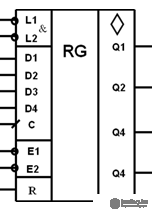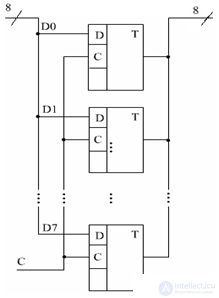Lecture
Registers
Register is a digital device intended for temporary storage of a numerical code and its conversion.
Symbol of four-digit register

L1 & L2 - record;
E1∨E2 - switching off the outputs;
The main elements of the register are binary cells, which are D-flip-flops.
Registers can be built on synchronous RS-triggers and JK-triggers.
To create an 8-bit number you need to have 8 triggers.
Types of registers RG
Sequential rg
• Sequential shift registers is a register in which data is entered bit by bit.
• For example, sequential loading of a 4-bit combination 0111 into a sequential shift register takes 5 clock cycles.
Sequential Shift Case

Parallel RG
A parallel register performs parallel data loading, in which all information bits (bits) are entered into the register simultaneously at the command of one clock pulse. It is possible to make a ring from a parallel register, then the information is not lost when moving.
Write when C = 1 Qi = Di C = 0
Qi is stored until a new number is written.
To write a new number you need to submit to C "1"

Comments
To leave a comment
Electronics, Microelectronics, Element Base
Terms: Electronics, Microelectronics, Element Base